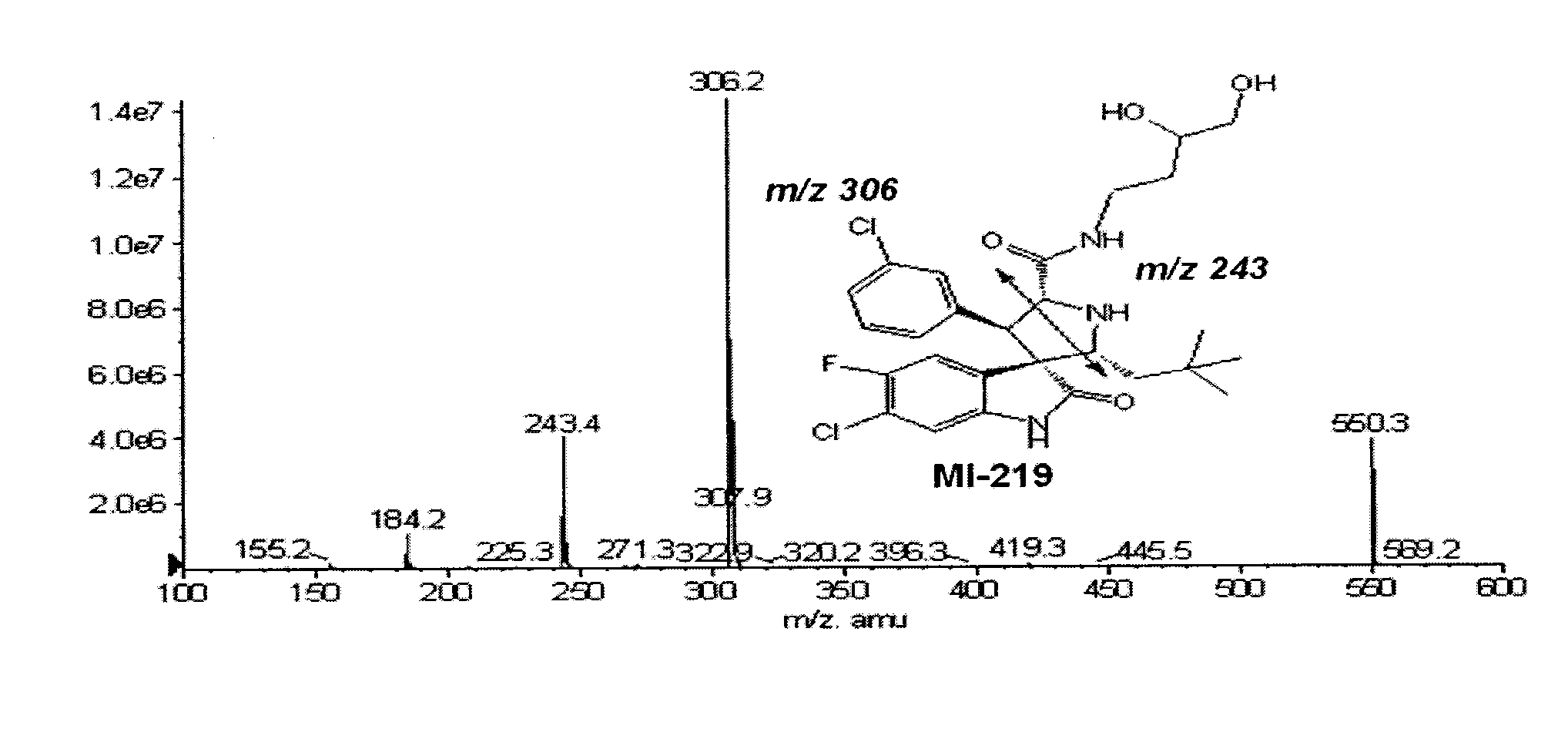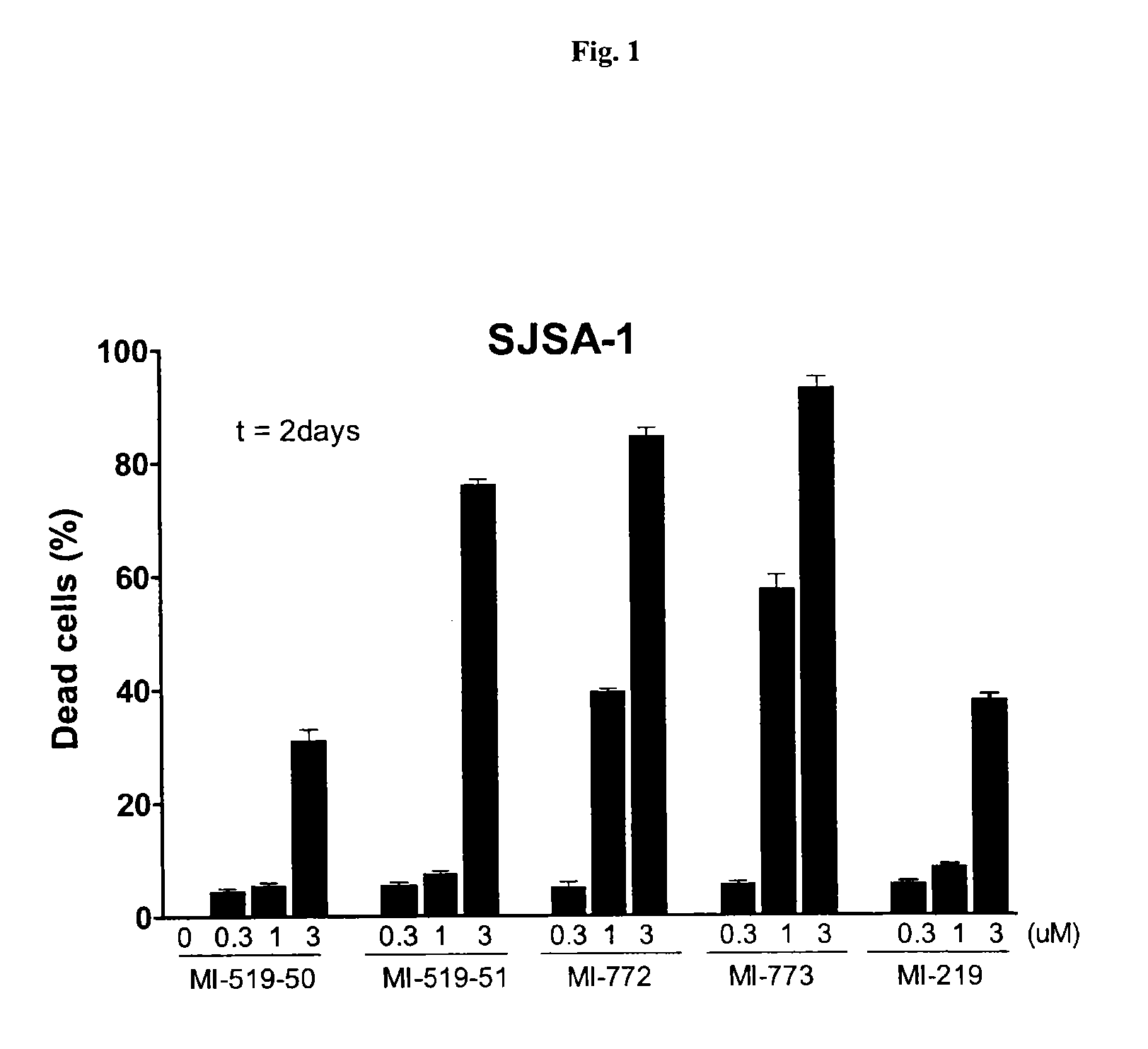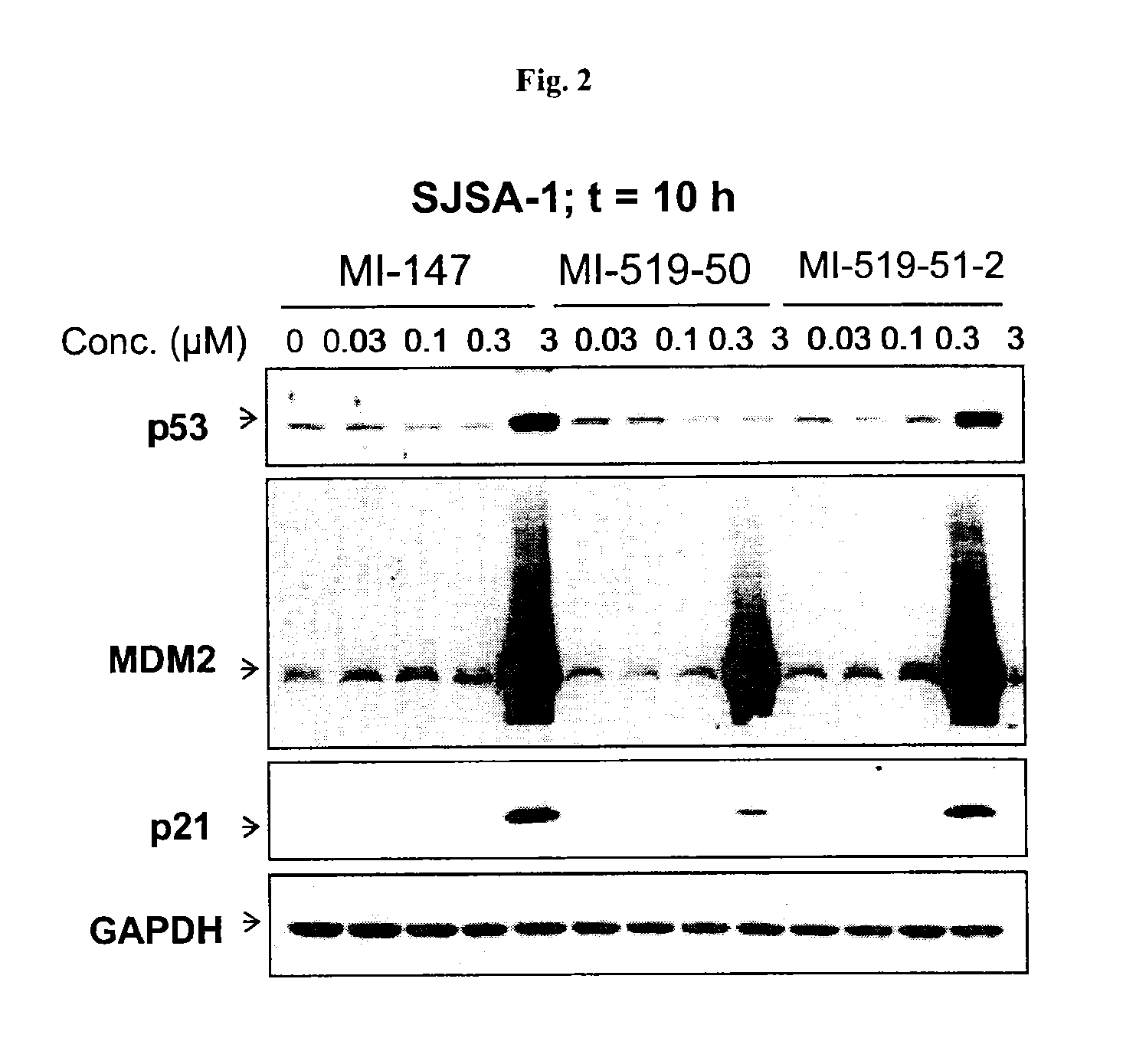Spiro-oxindole mdm2 antagonists
a technology of oxindole and mdm2, which is applied in the field of oxindole mdm2 antagonists, can solve the problems of poor cell permeability, inability to identify potent, non-peptide small molecule inhibitors, and poor cell permeability, and achieves less toxic, less toxic, and more tolerable effects
- Summary
- Abstract
- Description
- Claims
- Application Information
AI Technical Summary
Benefits of technology
Problems solved by technology
Method used
Image
Examples
example 1
Analytical Data for Compounds
[0510]
[0511]1H NMR (300 MHz, CD3OD) δ 7.72 (d, J=8.5 Hz, 1H), 7.32-7.21 (m, 3H), 7.08 (d, J=7.7 Hz, 1H), 6.87 (d, J=6.0 Hz, 1H), 5.25 (d, J=11.2 Hz, 1H), 4.50-4.47 (m, 1H), 4.11 (d, J=11.2 Hz, 1H), 4.05-3.97 (m, 2H), 3.67-3.38 (m, 2H), 2.61-2.56 (m, 2H), 1.92 (dd, J=15.5, 8.2 Hz, 1H), 1.20 (dd, J=15.5, 2.0 Hz, 1H), 0.92 (s, 9H); MS (ESI) m / z 550 [M+H]+.
[0512]1H NMR (300 MHz, CD3OD) δ 7.70 (m, 1H), 7.31-7.02 (m, 4H), 6.88-6.83 (m, 1H), 5.28 (d, J=11.3 Hz, 1H), 4.48-4.45 (m, 1H), 4.18-4.13 (m, 1H), 3.75-3.72 (m, 2H), 3.36-3.31 (m, 1H), 3.05-3.03 (m, 1H), 2.83-2.76 (m, 1H), 1.92 (dd, J=15.4, 8.4 Hz, 1H), 1.65-1.53 (2H), 1.36 (s, 9H), 1.17 (d, J=15.4 Hz, 1H), 0.92 (s, 9H); MS (ESI) m / z 607 [M+H]+.
[0513]1H NMR (300 MHz, CD3OD) δ 7.68 (d, J=8.5 Hz, 1H), 7.32-7.20 (m, 3H), 7.08 (d, J=7.7 Hz, 1H), 6.87 (d, J=6.0 Hz, 1H), 5.20 (d, J=11.2 Hz, 1H), 4.38 (d, J=7.8 Hz, 1H), 4.24-4.20 (m, 2H), 4.08 (d, J=11.2 Hz, 1H), 2.19-2.12 (m, 1H), 1.90-1.70 (m, 3H), 1.53-1.48 (m...
example 2
Fluorescence-Polarization MDM2 Binding Assay
[0579]The binding affinity of the MDM2 inhibitors was determined using an optimized, sensitive and quantitative fluorescence polarization-based (FP-based) binding assay using a recombinant human His-tagged MDM2 protein (residues 1-118) and a fluorescently tagged p53-based peptide.
[0580]The design of the fluorescence probe was based upon a previously reported high-affinity p53-based peptidomimetic compound (5-FAM-βAla-βAla-Phe-Met-Aib-pTyr-(6-C1-LTrp)-Glu-Ac3c-Leu-Asn-NH2 (SEQ ID NO: 1)) Garcia-Echeverria et al., J. Med. Chem. 43: 3205-3208 (2000)). This tagged peptide is called PMDM6-F. The Kd value of PMDM6-F with the recombinant MDM2 protein was determined from the saturation curve. MDM2 protein was serially double diluted in a Dynex 96-well, black, round-bottom plate, and the PMDM6-F peptide was added at 1 nM concentration. The assay was performed in the buffer: 100 mM potassium phosphate, pH 7.5; 100 μg / mL bovine gamma globulin; 0.02% ...
example 3
[0582]Isogenic HCT-116 colon cancer cell lines were a kind gift from Prof. Bert Vogelstein (Johns Hopkins, Baltimore, Md.) and were maintained in McCoy's 5 A medium containing 10% FBS. All other cell lines were obtained from ATCC, (Manassas, Va.) and were maintained in RPMI-1640 medium containing 10% FBS.
[0583]Cells were seeded in 96-well flat bottom cell culture plates at a density of 2−3×103 cells / well with compounds and incubated for 4 days. The rate of cell growth inhibition after treatment with increasing concentrations of the tested compounds was determined by WST-8 (2-(2-methoxy-4-nitrophenyl)-3-(4-nitrophenyl)-5-(2,4-disulfophenyl)-2H-tetrazolium monosodium salt (Dojindo Molecular Technologies Inc., Gaithersburg, Md.). WST-8 was added at a final concentration of 10% to each well, and then the plates were incubated at 37° C. for 2-3 hrs. The absorbance of the samples was measured at 450 nm using a TECAN ULTRA Reader. The concentration of the compounds that in...
PUM
| Property | Measurement | Unit |
|---|---|---|
| concentration | aaaaa | aaaaa |
| concentrations | aaaaa | aaaaa |
| concentrations | aaaaa | aaaaa |
Abstract
Description
Claims
Application Information
 Login to View More
Login to View More - R&D
- Intellectual Property
- Life Sciences
- Materials
- Tech Scout
- Unparalleled Data Quality
- Higher Quality Content
- 60% Fewer Hallucinations
Browse by: Latest US Patents, China's latest patents, Technical Efficacy Thesaurus, Application Domain, Technology Topic, Popular Technical Reports.
© 2025 PatSnap. All rights reserved.Legal|Privacy policy|Modern Slavery Act Transparency Statement|Sitemap|About US| Contact US: help@patsnap.com



